Middleton W.M. (ed.) Reference Data for Engineers: Radio, Electronics, Computer and Communications
Подождите немного. Документ загружается.

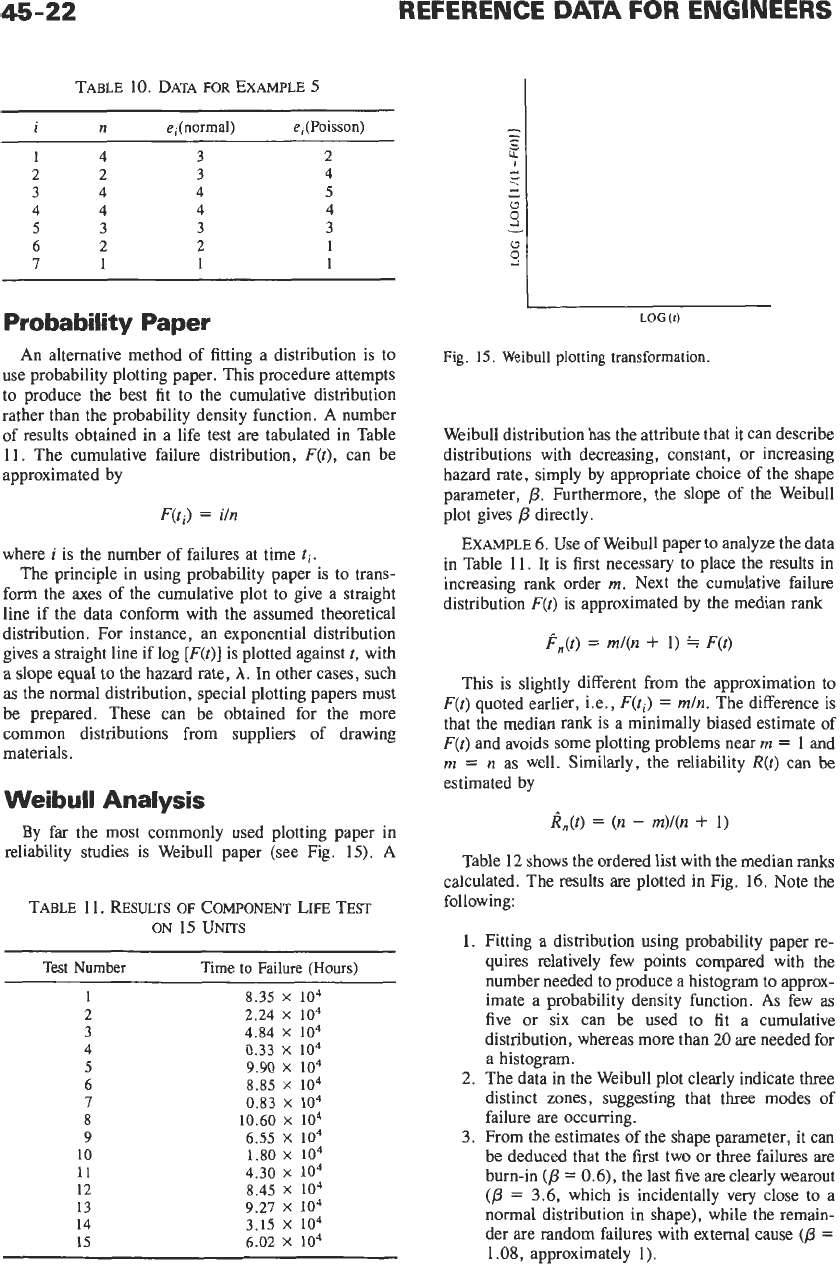
REFERENCE
DATA
FOR
TABLE
10.
DATA
FOR
EXAMPLE
5
1
n
ei(normal)
ei(Poisson)
1
4
3
2
2
2
3
4
3
4
4 5
4
4
4
4
5
3
3
3
6
2
2
1
7
1
1
1
Probability Paper
An alternative method of fitting a distribution is to
use probability plotting paper. This procedure attempts
to produce the best fit to the cumulative distribution
rather than the probability density function. A number
of results obtained in a life test are tabulated in Table
11.
The cumulative failure distribution,
F(t),
can be
approximated by
F(ti)
=
i/n
where
i
is the number of failures at time
ti.
The principle in using probability paper
is
to trans-
form the axes of the cumulative plot to give a straight
line if the data conform with the assumed theoretical
distribution. For instance, an exponential distribution
gives a straight line if log
[F(t)]
is plotted against
t,
with
a slope equal to
the
hazard rate,
A.
In other cases, such
as the normal distribution, special plotting papers must
be prepared. These can be obtained for the more
common distributions from suppliers of drawing
materials.
Weibull Analysis
By far the most commonly used plotting paper in
reliability studies is Weibull paper (see Fig.
15).
A
TABLE
11.
RESULTS
OF
COMPONENT LIFE TEST
ON
15
UNITS
Test Number
Time
to
Failure
(Hours)
1
2
3
4
5
6
7
8
9
10
11
12
13
14
15
8.35
x
io4
2.24
x
104
4.84
x
104
0.33
x
104
9.90
x
104
8.85
x
io4
0.83
x
104
6.55
x
104
1.80
x
104
4.30
x
104
8.45
x
104
9.27
x
104
3.15
x
104
6.02
x
104
10.60
X
lo4
L
LOG
(0
Fig.
15.
Weibull plotting transformation.
Weibull distribution has the attribute that it can describe
distributions with decreasing, constant, or increasing
hazard rate, simply by appropriate choice of the shape
parameter,
p.
Furthermore, the slope of the Weibull
plot gives
/3
directly.
EXAMPLE
6.
Use of Weibull paper to analyze the data
in Table
11.
It
is
first necessary to place the results in
increasing rank order
m.
Next the cumulative failure
distribution
F(t)
is approximated by the median rank
P,(t)
=
m/(n
+
1)
=
~(t)
This is slightly different from the approximation to
F(t)
quoted earlier, Le.,
F(ti)
=
mln.
The difference is
that the median rank
is
a minimally biased estimate of
F(t)
and avoids some plotting problems near
m
=
1
and
m
=
n
as well. Similarly, the reliability
R(t)
can
be
estimated by
Table
12
shows the ordered list with the median ranks
calculated. The results are plotted in Fig. 16. Note the
following:
Fitting a distribution using probability paper re-
quires relatively few points compared with the
number needed to produce a histogram to approx-
imate a probability density function. As few as
five or six can be used to fit a cumulative
distribution, whereas more than
20
are needed for
a histogram.
The data in the Weibull plot clearly indicate three
distinct zones, suggesting that three modes of
failure are occurring.
From the estimates
of
the shape parameter, it can
be deduced that the first two or three failures are
bum-in
(p
=
0.6),
the last five are clearly wearout
(p
=
3.6, which is incidentally very close to a
normal distribution in shape), while the remain-
der are random failures with external cause
(@
=
1.08,
approximately
1).
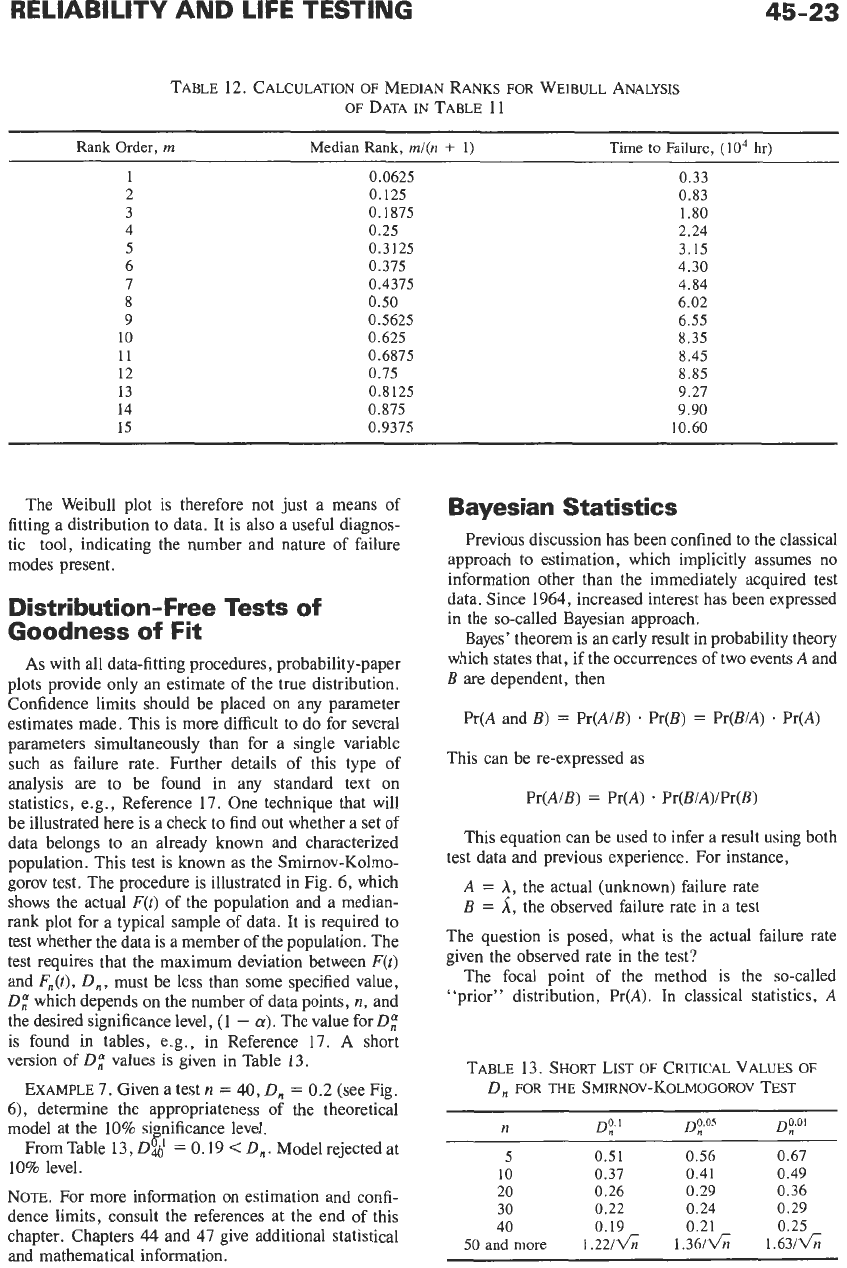
TABLE
12.
CALCULATION
OF
MEDIAN RANKS
FOR
WEIBULL ANALYSIS
OF
DATA
IN
TABLE 11
Rank Order,
rn
Median
Rank,
m/(n
+
1)
Time
to
Failure, (lo4
hr)
1 0.0625 0.33
2 0.125
0.83
3
0.1875 1.80
4 0.25 2.24
5 0.3125 3.15
6 0.375 4.30
7 0.4375 4.84
8
0.50 6.02
9 0.5625 6.55
10 0.625 8.35
11 0.6875 8.45
12 0.75 8.85
13 0.8125 9.27
14 0.875 9.90
15 0.9375 10.60
The Weibull plot
is
therefore not just a means of
fitting a distribution to data. It is also a useful diagnos-
tic tool, indicating the number and nature of failure
modes present.
Distribution-Free Tests
of
Goodness
of
Fit
As
with all data-fitting procedures, probability-paper
plots provide only an estimate of the true distribution.
Confidence limits should be placed on any parameter
estimates made. This is more difficult to do for several
parameters simultaneously than for a single variable
such as failure rate. Further details of this type of
analysis are to be found in any standard text
on
statistics, e.g., Reference 17. One technique that will
be illustrated here is a check to find out whether a set
of
data belongs to an already known and characterized
population. This test is known as the Smirnov-Kolmo-
gorov test. The procedure is illustrated in Fig. 6, which
shows the actual
F(t)
of the population and a median-
rank plot for a typical sample of data. It is required to
test whether the data is a member of the population. The
test requires that the maximum deviation between
F(t)
and
F,(t),
D,,
must be less than some specified value,
0,"
which depends on the number of data points,
n,
and
the desired significance level,
(1
-
a).
The value for
0:
is found in tables, e.g., in Reference
17.
A short
version
of
0,"
values is given
in
Table
13.
EXAMPLE
7.
Given a test
n
=
40,
D,
=
0.2
(see Fig.
6), determine the appropriateness of the theoretical
model at the
10%
significance level.
FromTable
13,0%'
=
0.19
<
D,. Modelrejectedat
10%
level.
NOTE. For more information
on
estimation and confi-
dence limits, consult the references at the end of this
chapter. Chapters 44 and
47
give additional statistical
and mathematical information.
Bayesian Statistics
Previous discussion has been confined to the classical
approach to estimation, which implicitly assumes no
information other than the immediately acquired test
data. Since 1964, increased interest has been expressed
in the so-called Bayesian approach.
Bayes' theorem is an early result in probability theory
which states that, if the occurrences of two events
A
and
B
are dependent, then
Pr(A and
B)
=
Pr(A/B)
*
Pr(B)
=
Pr(B/A)
.
Pr(A)
This can be re-expressed as
Pr(AIB)
=
Pr(A)
.
Pr(B/A)/Pr(B)
This equation can be used to infer a result using both
test data and previous experience. For instance,
A
=
4,
the actual (unknown) failure rate
B
=
A,
the observed failure rate in a test
The question is posed, what
is
the actual failure rate
given the observed rate in the test?
The focal point of the method
is
the so-called
"prior" distribution, Pr(A). In classical statistics,
A
TABLE
13.
SHORT LIST
OF
CRITICAL VALUES
OF
D,
FOR
THE
SMIRNOV-KOLMOGOROV TEST
n
n
5 0.51
0.56 0.67
10
0.37
0.41 0.49
20 0.26 0.29
0.36
30
0.22
0.24 0.29
40 0.19 0.21
0.25
n
D:O'
Do.'
~0.05
50
and
more 1.22Ifi 1.361fi 1.63/6
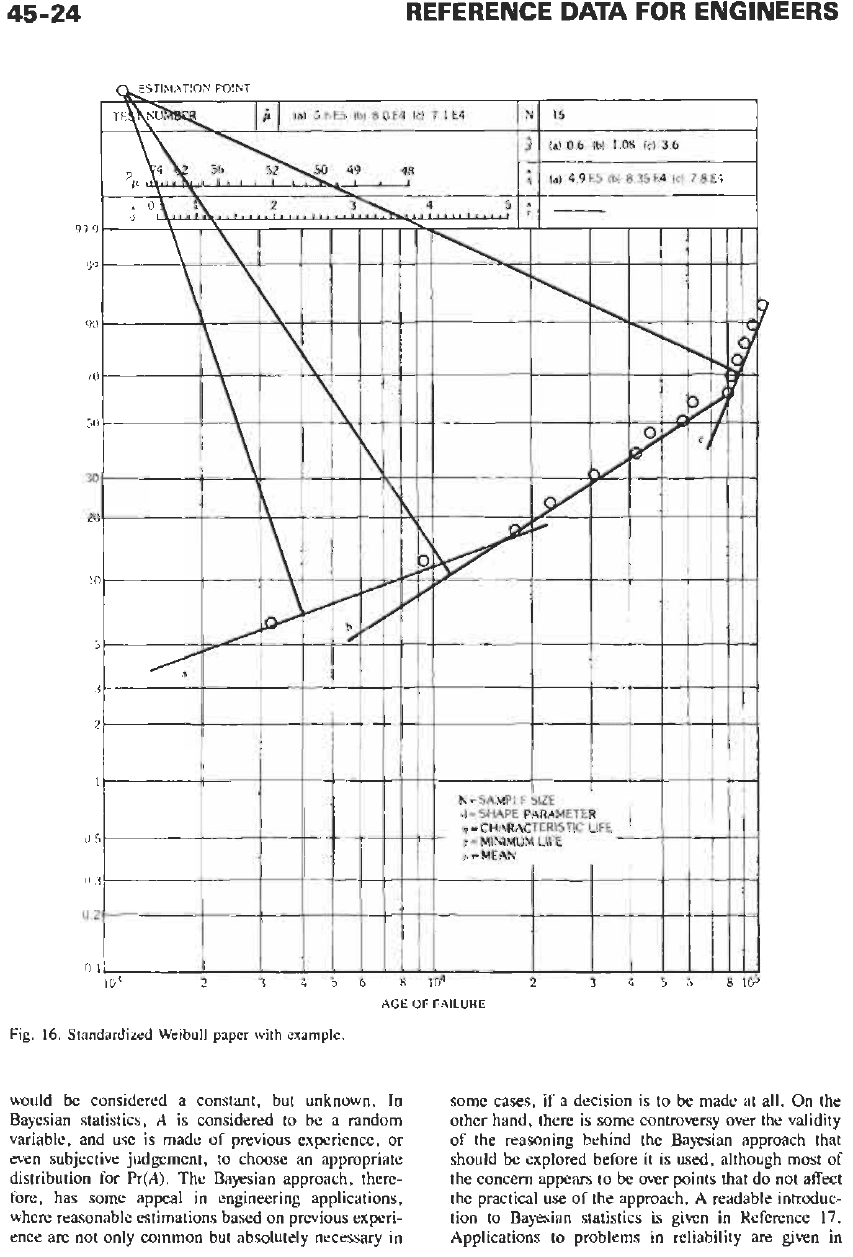
45-24
REFERENCE
DATA
FOR
ENGINEERS
Fig.
16.
Standardized
Weibull
paper
with
example.
would be considered a constant, but unknown. In
Bayesian statistics,
A
is considered to be a random
variable, and use is made of previous experience, or
even subjective judgement, to choose an appropriate
distribution for Pr(A). The Bayesian approach, there-
fore, has some appeal in engineering applications,
where reasonable estimations based on previous experi-
ence are not only common but absolutely necessary in
some cases, if a decision is to be made at all. On the
other hand, there is some controversy over the validity
of the reasoning behind the Bayesian approach that
should be explored before it
is used, although most of
the concern appears to be over points that do not affect
the practical use
of
the approach. A readable introduc-
tion to Bayesian statistics is given in Reference
17.
Applications to problems in reliability are given in
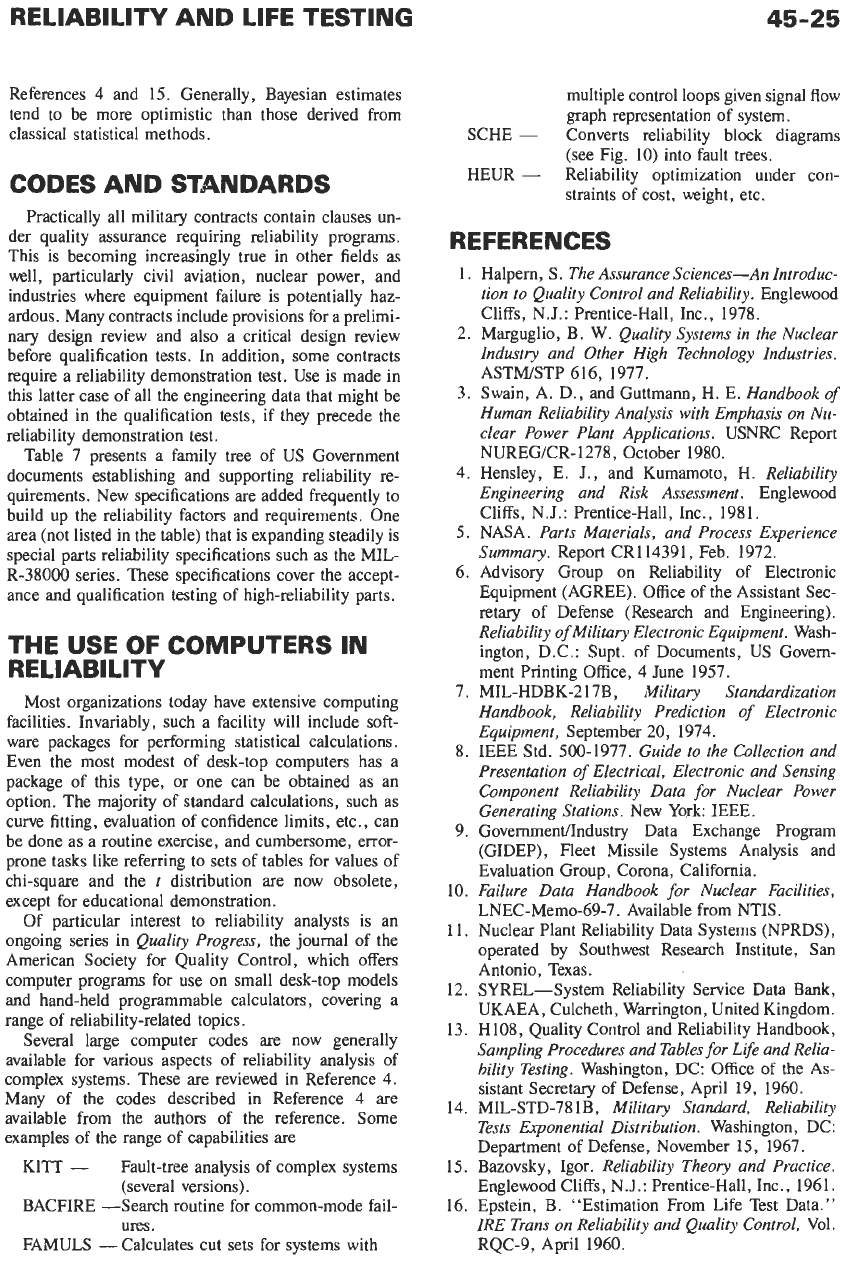
References 4 and 15. Generally, Bayesian estimates
tend to be more optimistic than those derived from
classical statistical methods.
CODES
AND
STANDARDS
Practically all military contracts contain clauses un-
der quality assurance requiring reliability programs.
This is becoming increasingly true in other fields as
well, particularly civil aviation, nuclear power, and
industries where equipment failure is potentially haz-
ardous. Many contracts include provisions for a prelimi-
nary
design review and also a critical design review
before qualification tests. In addition, some contracts
require a reliability demonstration test. Use is made in
this latter case of all the engineering data that might be
obtained in the qualification tests, if they precede the
reliability demonstration test.
Table
7
presents a family tree of US Government
documents establishing and supporting reliability re-
quirements. New specifications are added frequently to
build up the reliability factors and requirements. One
area (not listed in the table) that is expanding steadily is
special parts reliability specifications such as the MIL-
R-38000 series. These specifications cover
the
accept-
ance and qualification testing of high-reliability parts.
THE USE OF COMPUTERS
IN
RELIABILITY
Most organizations today have extensive computing
facilities. Invariably, such a facility will include
soft-
ware packages for performing statistical calculations.
Even the most modest of desk-top computers has a
package of this type, or one can be obtained as an
option. The majority of standard calculations, such as
curve fitting, evaluation of confidence limits, etc., can
be done as a routine exercise, and cumbersome, error-
prone tasks like referring to sets of tables for values of
chi-square and the
t
distribution are now obsolete,
except for educational demonstration.
Of particular interest to reliability analysts is an
ongoing series in
Quality Progress,
the journal of the
American Society for Quality Control, which offers
computer programs for use
on
small desk-top models
and hand-held programmable calculators, covering a
range of reliability-related topics.
Several large computer codes are
now
generally
available
for
various aspects of reliability analysis of
complex systems. These are reviewed in Reference 4.
Many of the codes described in Reference
4
are
available from the authors of the reference. Some
examples of the range of capabilities are
multiple control loops given signal flow
graph representation
of
system.
SCHE
-
Converts reliability block diagrams
(see Fig. 10) into fault trees.
HEUR
-
Reliability optimization under con-
straints of cost, weight, etc.
REFERENCES
MIL-HDBK-2 17B,
Military Standardization
Handbook, Reliability Prediction
of
Electronic
Equipment,
September 20, 1974.
IEEE Std. 500-1977.
Guide to the Collection and
Presentation
of
Electrical, Electronic and Sensing
Component Reliability Data for Nuclear Power
Generating Stations.
New York: IEEE.
Govemment/Industry Data Exchange Program
(GIDEP), Fleet Missile Systems Analysis and
Evaluation Group, Corona, California.
Failure Data Handbook
for
Nuclear Facilities,
LNEC-Memo-69-7. Available from NTIS.
Nuclear Plant Reliability Data Systems (NPRDS),
operated by Southwest Research Institute, San
Antonio, Texas.
SYREL-System Reliability Service Data Bank,
UKAEA, Culcheth, Warrington, United Kingdom.
H108, Quality Control and Reliability Handbook,
Sampling Procedures and Tables
for
Lqe and Relia-
bility Testing.
Washington, DC: Office of the
As-
sistant Secretary of Defense, April 19, 1960.
14. MIL-STD-78 lB,
Military Standard, Reliability
Tests Exponential Distribution.
Washington, DC:
Department of Defense, November 15, 1967.
15. Bazovsky, Igor.
Reliability Theory and Practice.
Englewood Cliffs,
N.J.:
Prentice-Hall, Inc., 1961.
16. Epstein, B. “Estimation From Life Test Data.”
IRE Trans
on
Reliability and Quality Control, Vol.
RQC-9, April 1960.
KITT
-
Fault-tree analysis of complex systems
(several versions).
BACFIRE -Search routine for common-mode fail-
ures
.
FAMULS
-
Calculates cut sets for systems with
1. Halpern,
S
.
The Assurance Sciences-An Introduc-
tion to Quality Control and Reliability.
Englewood
Cliffs, N.J.: Prentice-Hall, Inc., 1978.
2.
Marguglio, B. W.
Quality Systems in the Nuclear
Industry and Other High Technology Industries.
ASTMlSTP 6 16, 1977.
3.
Swain, A. D., and Guttmann, H.
E.
Handbook
of
Human Reliability Analysis with Emphasis
on
Nii-
clear Power Plant Applications.
USNRC Report
NUREG/CR-1278, October 1980.
4.
Hensley,
E.
J.,
and Kumamoto, H.
Reliability
Engineering and Risk Assessment.
Englewood
Cliffs, N.J.: Prentice-Hall, Inc., 1981.
5. NASA.
Parts Materials, and Process Experience
Summary.
Report CR114391, Feb. 1972.
6. Advisory Group on Reliability of Electronic
Equipment (AGREE). Office of the Assistant Sec-
retary of Defense (Research and Engineering).
Reliability
of
Military Electronic Equipment.
Wash-
ington, D.C.: Supt. of Documents, US Govern-
ment Printing Office, 4 June 1957.
7.
8.
9.
10.
11.
12.
13.
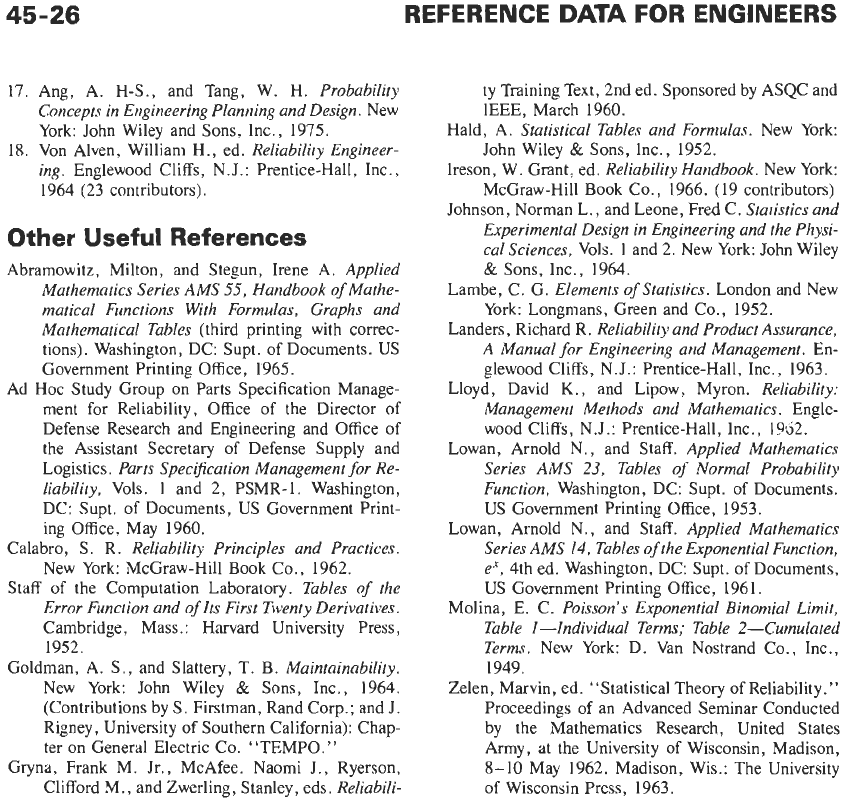
17. Ang, A. H-S., and Tang, W.
H.
Probability
Concepts in Engineering Planning and Design.
New
York: John Wiley and Sons, Inc., 1975.
18.
Von Alven, William
H.,
ed.
Reliability Engineer-
ing.
Englewood Cliffs, N.J.: Prentice-Hall, Inc.,
1964 (23 contributors).
Other
Useful
References
Abramowitz, Milton, and Stegun, Irene A.
Applied
Mathematics Series AMS
55,
Handbook
of
Mathe-
matical Functions With Formulas, Graphs and
Mathematical Tables
(third printing with correc-
tions). Washington, DC: Supt. of Documents. US
Government Printing Office, 1965.
Ad Hoc Study Group on Parts Specification Manage-
ment for Reliability, Office of the Director of
Defense Research and Engineering and Office of
the Assistant Secretary of Defense Supply and
Logistics.
Parts Spec@cation Management for Re-
liability,
Vols.
1
and 2,
PSMR-1.
Washington,
DC: Supt. of Documents, US Government Print-
ing Office, May 1960.
Calabro,
S.
R.
Reliability Principles and Practices.
New York: McGraw-Hill Book Co., 1962.
Staff of the Computation Laboratory.
Tables
of
the
Error Function and
of
Its First Twenty Derivatives.
Cambridge, Mass.
:
Harvard University Press,
1952.
Goldman, A.
S.,
and Slattery, T. B.
Maintainability.
New York: John Wiley
&
Sons, Inc., 1964.
(Contributions by
S.
Firstman, Rand Corp.; and J.
Rigney
,
University of Southern California): Chap-
ter on General Electric Co. “TEMPO.”
Gryna, Frank M. Jr., McAfee. Naomi J., Ryerson,
Clifford M., and Zwerling, Stanley, eds.
Reliabili-
ty Training Text, 2nd ed. Sponsored by ASQC and
IEEE, March 1960.
Hald, A.
Statistical Tables and Formulas.
New York:
John Wiley
&
Sons, Inc., 1952.
Ireson, W. Grant, ed.
Reliability Handbook.
New York:
McGraw-Hill Book Co., 1966. (19 contributors)
Johnson, Norman L., and Leone, Fred C.
Statistics and
Experimental Design in Engineering and the Physi-
cal Sciences,
Vols.
1
and 2. New York: John Wiley
&
Sons, Inc., 1964.
Lambe, C. G.
Elements
of
Statistics.
London and New
York: Longmans, Green and Co., 1952.
Landers, Richard R.
Reliability and Product Assurance,
A Manual for Engineering and Management.
En-
glewood Cliffs, N.J.: Prentice-Hall, Inc., 1963.
Lloyd, David
K.,
and Lipow, Myron.
Reliability:
Management Methods and Mathematics.
Engle-
wood Cliffs, N.J.: Prentice-Hall, Inc., 1952.
Lowan, Arnold N., and Staff.
Applied Mathematics
Series AMS
23,
Tables
of
Normal Probability
Function,
Washington, DC: Supt. of Documents.
US Government Printing Office, 1953.
Lowan, Arnold
N.,
and Staff.
Applied Mathematics
Series AMS
14,
Tables
of
the Exponential Function,
e”,
4th ed. Washington, DC: Supt. of Documents,
US Government Printing Office,
1961.
Molina, E. C.
Poisson’s Exponential Binomial Limit,
Table
I
--Individual Terms; Table 2-Cumulated
Terms.
New York: D. Van Nostrand Co., Inc.,
1949.
Zelen, Marvin, ed. “Statistical Theory of Reliability.”
Proceedings of an Advanced Seminar Conducted
by the Mathematics Research, United States
Army, at the University of Wisconsin, Madison,
8-10 May 1962. Madison, Wis.: The University
of Wisconsin Press, 1963.
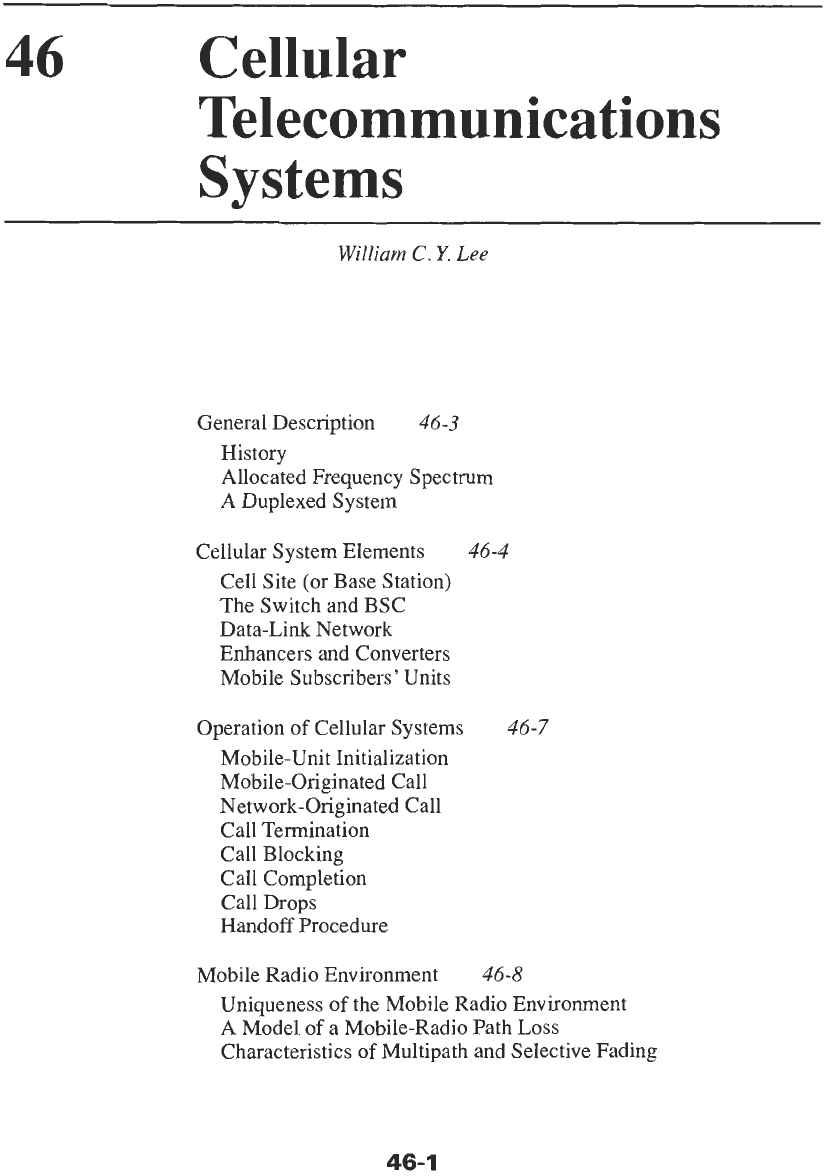
46
Cellular
Telecommunications
Systems
William
C.
Y.
Lee
General Description
46-3
History
Allocated Frequency Spectrum
A
Duplexed System
Cellular System Elements
46-4
Cell Site (or Base Station)
The Switch and BSC
Data-Link Network
Enhancers and Converters
Mobile Subscribers’ Units
Operation
of
Cellular Systems
46-7
Mobile-Unit Initialization
Mobile-Originated Call
Network-Originated Call
Call Termination
Call Blocking
Call Completion
Call Drops
Handoff Procedure
Mobile Radio Environment
46-8
Uniqueness
of
the Mobile Radio Environment
A
Model
of
a Mobile-Radio Path Loss
Characteristics
of
Multipath and Selective Fading
46-1
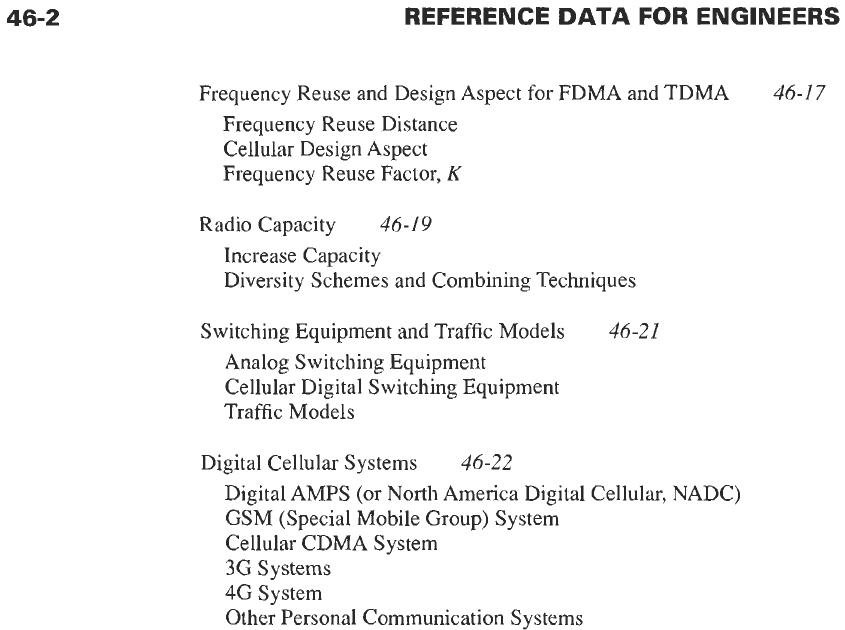
46-2
Frequency Reuse and Design Aspect for FDMA and TDMA
46-1
7
Frequency Reuse Distance
Cellular Design Aspect
Frequency Reuse Factor,
K
Radio Capacity
46-1
9
Increase Capacity
Diversity Schemes and Combining Techniques
Switching Equipment and Traffic Models
Analog Switching Equipment
Cellular Digital Switching Equipment
Traffic Models
46-21
Digital Cellular Systems
46-22
Digital AMPS (or North America Digital Cellular, NADC)
GSM (Special Mobile Group) System
Cellular CDMA System
3G Systems
4G System
Other Personal Communication Systems
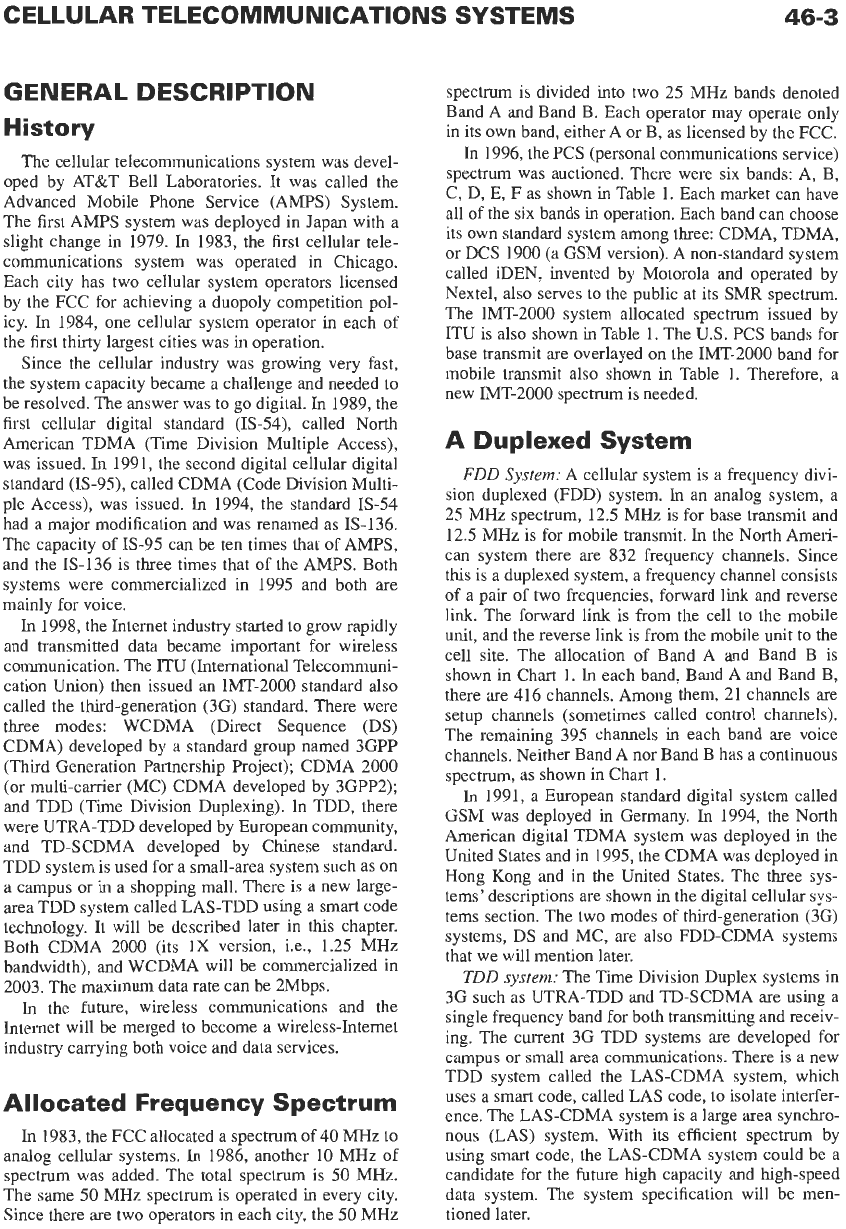
GENERAL DESCRIPTION
History
The cellular telecommunications system was devel-
oped by AT&T Bell Laboratories. It was called the
Advanced Mobile Phone Service (AMPS) System.
The first AMPS system was deployed in Japan with a
slight change in 1979. In 1983, the first cellular tele-
communications system was operated
in
Chicago.
Each city has two cellular system operators licensed
by the FCC for achieving a duopoly competition pol-
icy. In 1984, one cellular system operator in each of
the first thirty largest cities was in operation.
Since the cellular industry was growing very fast,
the system capacity became a challenge and needed
to
be resolved. The answer was
to
go digital. In 1989, the
first cellular digital standard (IS-54), called
North
American TDMA (Time Division Multiple Access),
was issued. In 1991, the second digital cellular digital
standard (IS-95), called CDMA (Code Division Multi-
ple Access), was issued. In 1994, the standard IS-54
had a major modification and was renamed as IS-136.
The capacity of IS-95 can be ten times that of AMPS,
and the IS-136 is three times that of the AMPS. Both
systems were commercialized in 1995 and both are
mainly for voice.
In 1998, the Internet industry started to grow rapidly
and transmitted data became important for wireless
communication. The ITU (International Telecommuni-
cation Union) then issued an IMT-2000 standard also
called the third-generation (3G) standard. There were
three modes: WCDMA (Direct Sequence (DS)
CDMA) developed by a standard group named 3GPP
(Third Generation Partnership Project); CDMA 2000
(or multi-carrier (MC) CDMA developed by 3GPP2);
and TDD (Time Division Duplexing). In TDD, there
were UTRA-TDD developed by European community,
and TD-SCDMA developed by Chinese standard.
TDD system is used for a small-area system such as
on
a campus or
in
a shopping mall. There is a new large-
area TDD system called LAS-TDD using a smart code
technology. It will be described later in
this
chapter.
Both CDMA 2000 (its 1X version, i.e., 1.25 MHz
bandwidth), and WCDMA will be commercialized in
2003. The maximum data rate can be 2Mbps.
In the future, wireless communications and the
Internet will be merged
to
become a wireless-Internet
industry carrying both voice and data services.
Allocated Frequency Spectrum
In 1983, the FCC allocated a spectrum of 40 MHz to
analog cellular systems. In 1986, another 10 MHz of
spectrum was added. The total spectrum is 50 MHz.
The same 50 MHz spectrum is operated in every city.
Since there are two operators in each city, the
50
MHz
spectrum is divided into two 25 MHz bands denoted
Band A and Band B. Each operator may operate only
in its own band, either A or B, as licensed by the FCC.
In 1996, the PCS (personal communications service)
spectrum was auctioned. There were six bands: A, B,
C, D, E, F as shown
in
Table 1. Each market can have
all
of
the six bands
in
operation. Each band can choose
its own standard system among three: CDMA, TDMA,
or DCS 1900 (a GSM version). A non-standard system
called iDEN, invented by Motorola and operated by
Nextel, also serves to the public at its SMR spectrum.
The IMT-2000 system allocated spectrum issued by
ITU is
also
shown
in
Table
1.
The U.S. PCS bands for
base transmit are overlayed
on
the IMT-2000 band for
mobile transmit also shown in Table 1. Therefore, a
new IMT-2000 spectrum is needed.
A Duplexed System
FDD
System:
A cellular system is a frequency divi-
sion duplexed (FDD) system. In an analog system, a
25 MHz spectrum, 12.5 MHz is for base transmit and
12.5 MHz is for mobile transmit. In the
North
Ameri-
can system there are 832 frequency channels. Since
this
is a duplexed system, a frequency channel consists
of
a pair of two frequencies, forward link and reverse
link. The forward link
is
from the cell to the mobile
unit, and the reverse link is from the mobile unit to the
cell site. The allocation
of
Band A and Band B is
shown in Chart 1. In each band, Band A and Band B,
there are 416 channels. Among them, 21 channels are
setup channels (sometimes called control channels).
The remaining 395 channels in each band are voice
channels. Neither Band A nor Band
B
has a continuous
spectrum, as shown in Chart 1.
In 1991, a European standard digital system called
GSM was deployed in Germany. In 1994, the North
American digital TDMA system was deployed in the
United States and in 1995, the CDMA was deployed in
Hong Kong and in the United States. The three sys-
tems’ descriptions are shown
in
the digital cellular sys-
tems section. The two modes of third-generation (3G)
systems, DS and MC, are also FDD-CDMA systems
that we will mention later.
TDD
system:
The Time Division Duplex systems in
3G such as UTRA-TDD and TD-SCDMA are using a
single frequency band for both transmitting and receiv-
ing.
The current 3G TDD systems are developed for
campus
or
small area communications. There
is
a
new
TDD system called the LAS-CDMA system, which
uses a smart code, called LAS code, to isolate interfer-
ence. The LAS-CDMA system is a large area synchro-
nous
(LAS) system. With its efficient spectrum by
using smart code, the LAS-CDMA system could be a
candidate for the future high capacity and high-speed
data system. The system specification will be men-
tioned later.
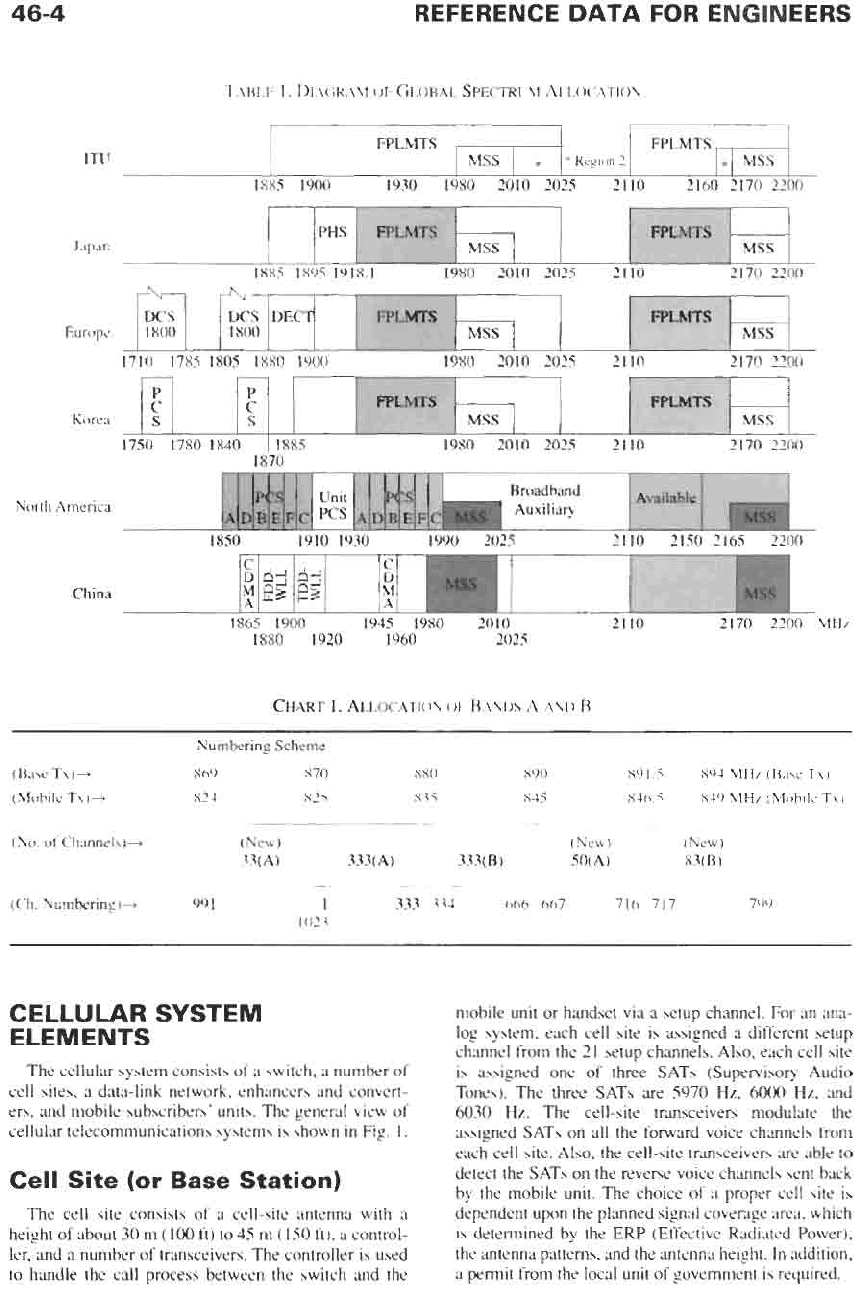
464
REFERENCE
DATA
FOR ENGINEERS
WLMTS
ITU
MSS
*Region2
TABLE
1.
DIAGRAM
OF
GLOBAL
SPECTRUM ALLOCATION
WLMTS
*
MSS
rruw
I
3
DCS
DELI
1710 1785
1805
1880
1900
1080 2010
202.5
-
-
m
rrui
I
3
P
P
C C
Korea
s
S
MSS
China
110
7170
200
MHz
1880 1920 1960 2025
m.
FPLMTS
MSS
2170 2200 2110
I
FPLMTS
MSS
CHART
1.
ALLOCATION
OF
BANDS
A
AND
B
Numbering Scheme
(Rase
Tx)+
869
870
880
890
891 .5 894 MHz
(Base
Tx)
(Mobile
Tx)+
824 825
835
845
846.5 849
MHz (Mohile Tx)
1750 1780 1840
(No.
of
Channels)+
1885
1980
2010 2025 2110 2170 2200
I
(Ch.
Numbering)+
99
1
1
333
334 666 667 716 717 799
1023
CELLULAR
ELEMENTS
SYSTEM
The cellular system consists
of
a switch, a number of
cell sites, a data-link network, enhancers and convert-
ers, and mobile subscribers' units. The general view of
cellular telecommunications systems is shown in Fig.
1.
Cell
Site
(or
Base Station)
The cell site consists of a cell-site antenna with
a
height of about
30
m
(100
ft) to
45
m
(150
ft),
a
control-
ler, and a number
of
transceivers. The controller is used
to handle the call process between the switch and the
mobile unit
or
handset via
a
setup channel. For an ana-
log system, each cell site is assigned
a
different setup
channel from the
21
setup channels.
Also,
each cell site
is assigned one of three
SATs
(Supervisory Audio
Tones). The
three
SATs
are
5970
Hz,
6OOO
Hz,
and
6030
Hz.
The cell-site transceivers modulate the
assigned
SATs
on
all
the forward voice channels from
each cell site. Also, the cell-site transceivers
are
able to
detect
the
SATs
on
the
reverse voice channels sent back
by the mobile unit.
The
choice of a proper cell site is
dependent upon the planned signal coverage area, which
is determined by the
ERP
(Effective Radiated Power),
the
antenna patterns, and the antenna height.
In
addition,
a permit from the
local
unit
of
government is required.
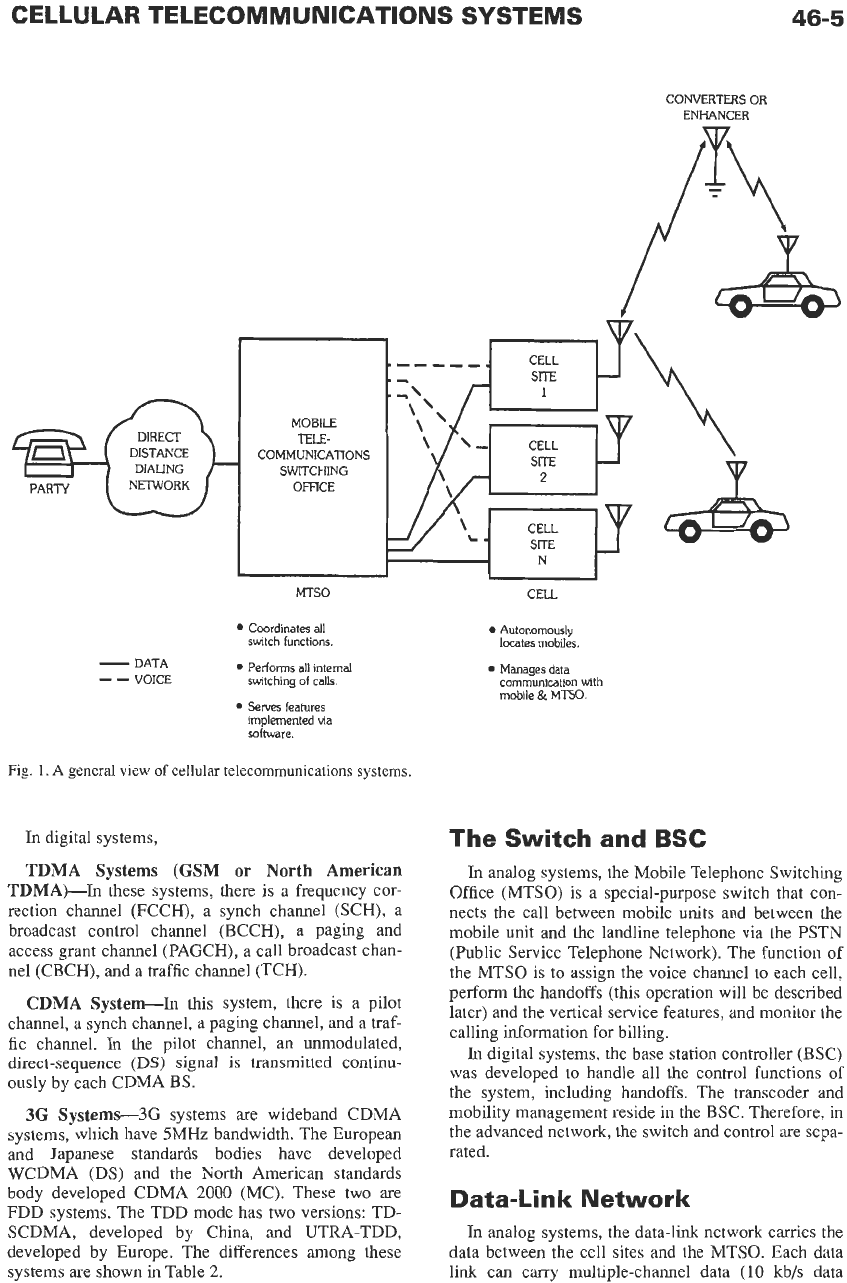
CELLULAR TELECOMMUNICATIONS SYSTEMS
46-5
CONVERTERS
OR
ENHANCER
SWITCHING
MTSO CELL
Coordinates all
switch functions
-
DATA
- -
VOICE
Performs
all internal
switching
of
calls.
implemented via
software.
Selves features
Autonomously
locates mobiles
Manages data
communication
with
mobile
&
MTSO.
Fig.
1.
A
general view
of
cellular telecommunications systems.
In
digital systems,
The Switch and
BSC
TDMA Systems (GSM or North American In
analog systems, the Mobile Telephone Switching
Office (MTSO) is a special-purpose switch that con-
nects the call between mobile units and between the
mobile unit and
the
landline telephone via the PSTN
(Public Service Telephone Network). The function of
the MTSO is to assign the voice channel
to
each cell,
TDMA)-In
these systems, there is a frequency cor-
rection channel (FCCH), a synch channel (SCH), a
broadcast control channel (BCCH), a paging and
access grant channel (PAGCH), a call broadcast chan-
ne1 (CBCH), and a traffic channel (TCH).
perform the handoffs (this operation will be described
later) and the vertical service features, and monitor the
calling
In
digital systems, the base station controller (BSC)
was developed to handle all the control functions of
the system, including handoffs. The transcoder and
mobility management reside in the BSC. Therefore, in
the advanced network, the switch and control are sepa-
CDMA
this
system’
there
is
a
channel, a synch channel, a paging channel, and a traf-
fic channel.
In
the pilot channel, an unmodulated,
direct-sequence
(DS)
signal
is
transmitted continu-
ously by each CDMA BS.
3G
Systems...-3G
systems are wideband CDMA
systems, which have 5MHz bandwidth. The European
and Japanese standards bodies have developed rated.
WCDMA (DS) and the North American standards
body developed CDMA
2000
(MC). These two
are
FDD systems. The TDD mode has two versions: TD-
SCDMA, developed by China, and UTRA-TDD,
developed by Europe. The differences among these
systems are shown in Table
2.
for
billing.
Data-Link
Network
In
analog systems, the data-link network carries the
data between the cell sites and the MTSO. Each data
link can carry multiple-channel data
(10
kb/s
data
